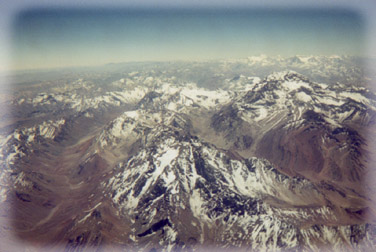
The Andes (photo credit: Barbara Smela, November 1998)
Travel in Latin America
(An excerpt from the book Travel
in Latin America
by Roland Soong, Barbara Smela and Risa Becker)
In Latin America, the distance between the Mexico-USA border at the northernmost point and Tierra del Fuego (Argentina) at the southernmost point is about 7,000 miles. The widest distance, which occurs between Peru in the west and Brazil in the east, is about 3,200 miles. Since colonial times and continuing even now, these vast distances have made travel long and arduous.
The ease of travel between two points is not simply measured in terms of the direct distance between them because the physical characteristics of the terrain have a tremendous impact.
Latin America is remarkable for its towering mountain ranges. Mexico is traversed by the three Sierra Madre ranges which extend south through Central America. In South America, the Andes run from Venezuela in the north all the way south to Tierra del Fuego in Argentina. There are only a few passes at which travelers can cross the Andes. East-west travel by land in South America is, therefore, generally difficult.

The Andes (photo credit: Barbara Smela, November 1998)
Apart from the mountains, Latin America is also remarkable for its vast river systems: the Amazon, the Orinoco and the Rio de la Plata systems. Although these rivers are navigable in many parts, they do not flow between the major population centers and therefore do not serve as major transportation arteries.
Given the characteristics of the physical terrain in Latin America, air travel has become a major mode of transportation. A discussion of air travel requires some distinction to be made between domestic (that is, intra-national) versus foreign (that is, international) travel. In the present state of the airline industry worldwide, it is typical that domestic routes are reserved for national airlines while international routes are increasingly deregulated for open competition among the international carriers. The demand for domestic and international travel varies among countries for a number of reasons.
At one extreme, a country with a small surface area (such as El Salvador) can be traversed by car in several hours. Air travel may therefore be inconsequential within the country. At the other extreme, a country with a large area (such as Brazil, which is almost as large as the USA) and without an expansive land-based transportation network will need to utilize air transportation extensively.
On one hand, a country with a large area and a large population would be more likely to have a strong demand for air travel inside the country. Argentina, Brazil, Colombia, Mexico and Peru fit these criteria.
On the other hand, a country with a small area and a small population would b less likely to have a strong demand for air travel inside the country. The Central American countries would fit these criteria.
The considerations based upon land area and population actually require a more complex analysis. It is important to consider how the population is dispersed across the country. Some countries are dominated by a single economic, political and cultural terms. The need to travel outside the country is therefore relatively small. In fact, the secondary cities may not be serviced regularly and extensively by scheduled air carriers. Examples of large primary cities are:
In other countries, there are a few primary cities. Usually, one is the political capital and the others are major business centers. Air travel may be quite frequent among these cities. Examples are:
In Brazil, the two megalopolises, Rio de Janeiro and Sao Paulo, do not dominate the population distribution as much as in other countries. The national capital is located in Brasilia. There are also a number of cities with sizeable populations.
In the above, we enumerated a number a reasons why we feel that air travel is the most efficient means of travel across Latin America.
Air travel is an economic market in which there are suppliers (namely, the airlines) and consumers (namely, people). There is great deal of information available to airline managers on the supply side, both in terms of actual data as well as management techniques. By comparison, much less is available or known on the demand side.
This asymmetry of information may have led to an overemphasis on supply-side aspects such as financing, equipment, productivity, cost containment and strategic alliances. But airline management, in this market as in any other, is always going to be about being able to match the supply of services to the demand for those services, and not the other way around. Even if the services appear to match the demand, there are still marketing and communication issues about how to bring the message to the consumers.
This is an attempt to redress the asymmetry of information by presenting a vast amount of information about Latin American air travelers. We will address questions such as the following:
We will provide our answers to these questions using the survey data from the Los Medios y Mercados de Latinoamérica studies. The data were obtained by interviewing a total number of 16,424 persons between the ages of 18 and 64 inclusive in the eighteen countries of Latin America during a three-year period --- 1996, 1997 and 1998.
(posted on 9/9/99)
(Return to Zona Latina's Home Page)